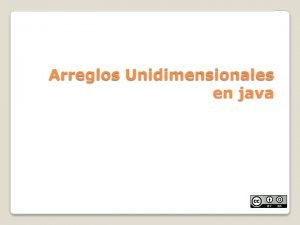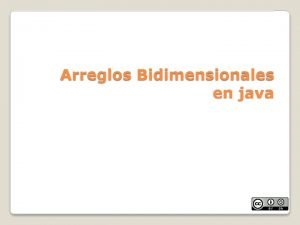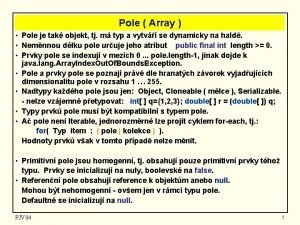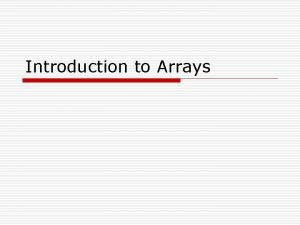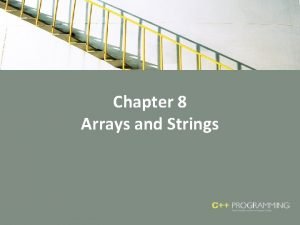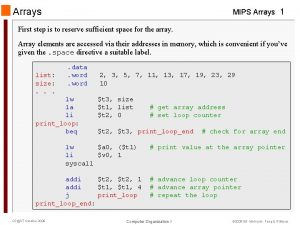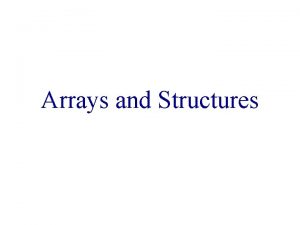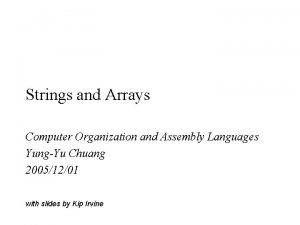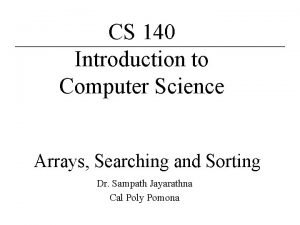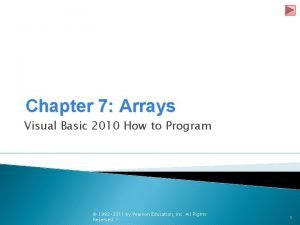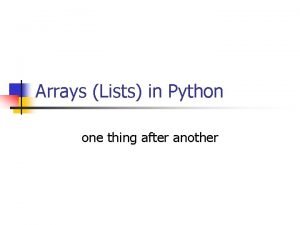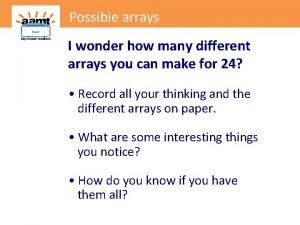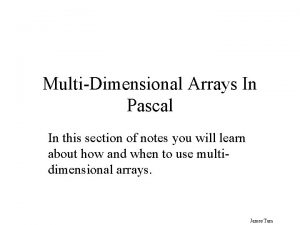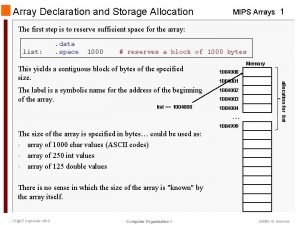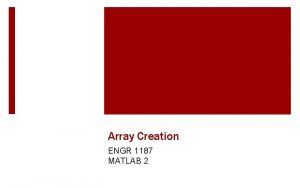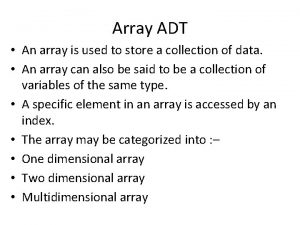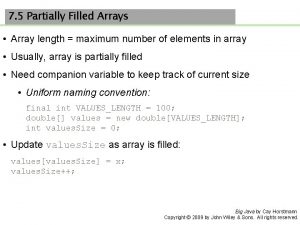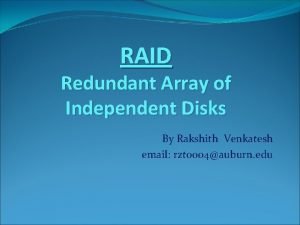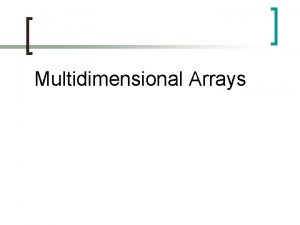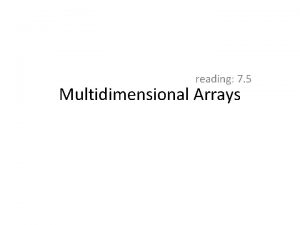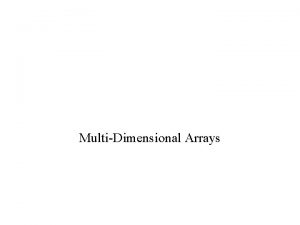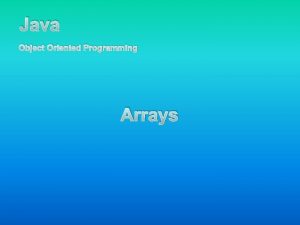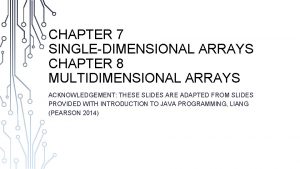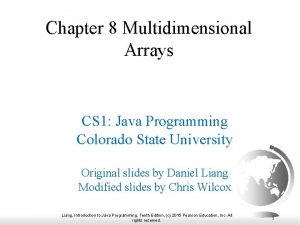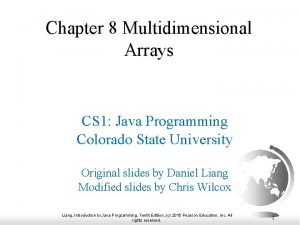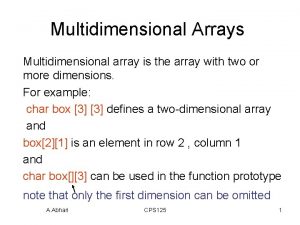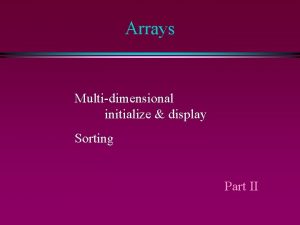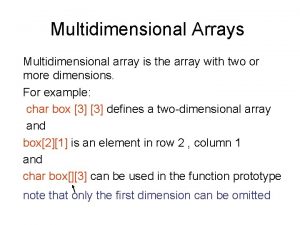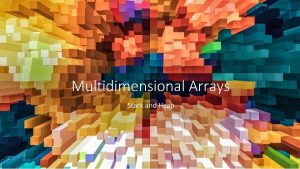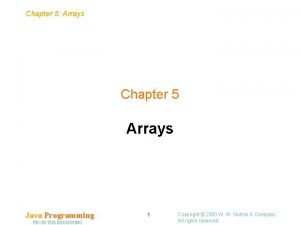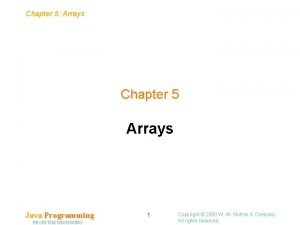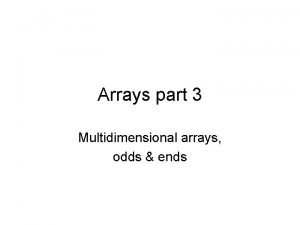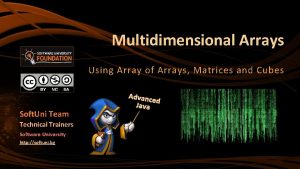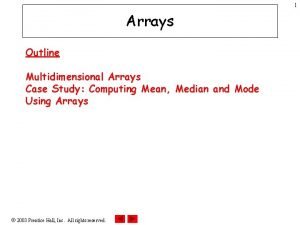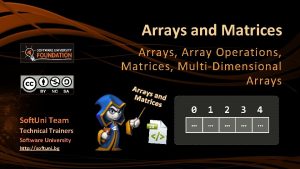Chapter 8 Multidimensional Arrays CS 1 Java Programming




![Declare/Create Two-dimensional Arrays // Declare array ref var data. Type[][] ref. Var; // Create Declare/Create Two-dimensional Arrays // Declare array ref var data. Type[][] ref. Var; // Create](https://slidetodoc.com/presentation_image_h/1b37aa496f7b13b00bd47473fefd4b23/image-5.jpg)
![Declaring Variables of Twodimensional Arrays and Creating Two -dimensional Arrays int[][] matrix = new Declaring Variables of Twodimensional Arrays and Creating Two -dimensional Arrays int[][] matrix = new](https://slidetodoc.com/presentation_image_h/1b37aa496f7b13b00bd47473fefd4b23/image-6.jpg)
![Two-dimensional Array Illustration matrix. length? 5 array. length? 4 matrix[0]. length? 5 array[0]. length? Two-dimensional Array Illustration matrix. length? 5 array. length? 4 matrix[0]. length? 5 array[0]. length?](https://slidetodoc.com/presentation_image_h/1b37aa496f7b13b00bd47473fefd4b23/image-7.jpg)

![Lengths of Two-dimensional Arrays int[][] x = new int[3][4]; Liang, Introduction to Java Programming, Lengths of Two-dimensional Arrays int[][] x = new int[3][4]; Liang, Introduction to Java Programming,](https://slidetodoc.com/presentation_image_h/1b37aa496f7b13b00bd47473fefd4b23/image-9.jpg)
![Lengths of Two-dimensional Arrays, cont. int[][] array = { {1, 2, 3}, {4, 5, Lengths of Two-dimensional Arrays, cont. int[][] array = { {1, 2, 3}, {4, 5,](https://slidetodoc.com/presentation_image_h/1b37aa496f7b13b00bd47473fefd4b23/image-10.jpg)





![Summing elements by column for (int column = 0; column<matrix[0]. length; column++){ int total Summing elements by column for (int column = 0; column<matrix[0]. length; column++){ int total](https://slidetodoc.com/presentation_image_h/1b37aa496f7b13b00bd47473fefd4b23/image-16.jpg)


![Multidimensional Arrays double[][][] scores = { {{7. 5, 20. 5}, {9. 0, 22. 5}, Multidimensional Arrays double[][][] scores = { {{7. 5, 20. 5}, {9. 0, 22. 5},](https://slidetodoc.com/presentation_image_h/1b37aa496f7b13b00bd47473fefd4b23/image-19.jpg)






- Slides: 25

Chapter 8 Multidimensional Arrays CS 1: Java Programming Colorado State University Original slides by Daniel Liang Modified slides by Chris Wilcox Liang, Introduction to Java Programming, Tenth Edition, (c) 2015 Pearson Education, Inc. All rights reserved. 1

Motivations Thus far, you have used one-dimensional arrays to model linear collections of elements. You can use a two-dimensional array to represent a matrix or a table. For example, the following table that describes the distances between the cities can be represented using a two-dimensional array. Liang, Introduction to Java Programming, Tenth Edition, (c) 2015 Pearson Education, Inc. All rights reserved. 2

Other Representations? What are some other representations of multidimensional arrays? Liang, Introduction to Java Programming, Tenth Edition, (c) 2015 Pearson Education, Inc. All rights reserved. 3

Motivations Liang, Introduction to Java Programming, Tenth Edition, (c) 2015 Pearson Education, Inc. All rights reserved. 4
![DeclareCreate Twodimensional Arrays Declare array ref var data Type ref Var Create Declare/Create Two-dimensional Arrays // Declare array ref var data. Type[][] ref. Var; // Create](https://slidetodoc.com/presentation_image_h/1b37aa496f7b13b00bd47473fefd4b23/image-5.jpg)
Declare/Create Two-dimensional Arrays // Declare array ref var data. Type[][] ref. Var; // Create array and assign its reference to variable ref. Var = new data. Type[10]; // Combine declaration and creation in one statement data. Type[][] ref. Var = new data. Type[10]; Liang, Introduction to Java Programming, Tenth Edition, (c) 2015 Pearson Education, Inc. All rights reserved. 5
![Declaring Variables of Twodimensional Arrays and Creating Two dimensional Arrays int matrix new Declaring Variables of Twodimensional Arrays and Creating Two -dimensional Arrays int[][] matrix = new](https://slidetodoc.com/presentation_image_h/1b37aa496f7b13b00bd47473fefd4b23/image-6.jpg)
Declaring Variables of Twodimensional Arrays and Creating Two -dimensional Arrays int[][] matrix = new int[10]; matrix[0][0] = 3; Liang, Introduction to Java Programming, Tenth Edition, (c) 2015 Pearson Education, Inc. All rights reserved. 6
![Twodimensional Array Illustration matrix length 5 array length 4 matrix0 length 5 array0 length Two-dimensional Array Illustration matrix. length? 5 array. length? 4 matrix[0]. length? 5 array[0]. length?](https://slidetodoc.com/presentation_image_h/1b37aa496f7b13b00bd47473fefd4b23/image-7.jpg)
Two-dimensional Array Illustration matrix. length? 5 array. length? 4 matrix[0]. length? 5 array[0]. length? 3 Liang, Introduction to Java Programming, Tenth Edition, (c) 2015 Pearson Education, Inc. All rights reserved. 7

Declaring, Creating, and Initializing Using Shorthand Notations You can also use an array initializer to declare, create and initialize a two-dimensional array. For example, int[][] array = { {1, 2, 3}, {4, 5, 6}, {7, 8, 9}, {10, 11, 12} }; Same as int[][] array = new int[4][3]; array[0][0] = 1; array[0][1] = 2; array[0][2] = 3; array[1][0] = 4; array[1][1] = 5; array[1][2] = 6; array[2][0] = 7; array[2][1] = 8; array[2][2] = 9; array[3][0] = 10; array[3][1] = 11; array[3][2] = 12; Liang, Introduction to Java Programming, Tenth Edition, (c) 2015 Pearson Education, Inc. All rights reserved. 8
![Lengths of Twodimensional Arrays int x new int34 Liang Introduction to Java Programming Lengths of Two-dimensional Arrays int[][] x = new int[3][4]; Liang, Introduction to Java Programming,](https://slidetodoc.com/presentation_image_h/1b37aa496f7b13b00bd47473fefd4b23/image-9.jpg)
Lengths of Two-dimensional Arrays int[][] x = new int[3][4]; Liang, Introduction to Java Programming, Tenth Edition, (c) 2015 Pearson Education, Inc. All rights reserved. 9
![Lengths of Twodimensional Arrays cont int array 1 2 3 4 5 Lengths of Two-dimensional Arrays, cont. int[][] array = { {1, 2, 3}, {4, 5,](https://slidetodoc.com/presentation_image_h/1b37aa496f7b13b00bd47473fefd4b23/image-10.jpg)
Lengths of Two-dimensional Arrays, cont. int[][] array = { {1, 2, 3}, {4, 5, 6}, {7, 8, 9}, {10, 11, 12} }; array. length array[0]. length array[1]. length array[2]. length array[3]. length array[4]. length? Array. Index. Out. Of. Bounds. Exception Liang, Introduction to Java Programming, Tenth Edition, (c) 2015 Pearson Education, Inc. All rights reserved. 10

Ragged Arrays Each row in a two-dimensional array is itself an array. So, the rows can have different lengths. Such an array is known as a ragged array. For example, int[][] matrix = { {1, 2, 3, 4, 5}, matrix. length is 5 matrix[0]. length is 5 {2, 3, 4, 5}, matrix[1]. length is 4 {3, 4, 5}, matrix[2]. length is 3 {4, 5}, matrix[3]. length is 2 matrix[4]. length is 1 {5} }; Liang, Introduction to Java Programming, Tenth Edition, (c) 2015 Pearson Education, Inc. All rights reserved. 11

Ragged Arrays, cont. Liang, Introduction to Java Programming, Tenth Edition, (c) 2015 Pearson Education, Inc. All rights reserved. 12

Initializing arrays with random values for (int row = 0; row < matrix. length; row++) { for (int column = 0; column < matrix[row]. length; column++) { matrix[row][column] = (int)(Math. random() * 100); } } Liang, Introduction to Java Programming, Tenth Edition, (c) 2015 Pearson Education, Inc. All rights reserved. 13

Printing arrays for (int row = 0; row < matrix. length; row++) { for (int column = 0; column < matrix[row]. length; column++) { System. out. print(matrix[row][column] + " "); } System. out. println(); } Liang, Introduction to Java Programming, Tenth Edition, (c) 2015 Pearson Education, Inc. All rights reserved. 14

Summing all elements int total = 0; for (int row = 0; row < matrix. length; row++) { for (int column = 0; column < matrix[row]. length; column++) { total += matrix[row][column]; } } Liang, Introduction to Java Programming, Tenth Edition, (c) 2015 Pearson Education, Inc. All rights reserved. 15
![Summing elements by column for int column 0 columnmatrix0 length column int total Summing elements by column for (int column = 0; column<matrix[0]. length; column++){ int total](https://slidetodoc.com/presentation_image_h/1b37aa496f7b13b00bd47473fefd4b23/image-16.jpg)
Summing elements by column for (int column = 0; column<matrix[0]. length; column++){ int total = 0; for (int row = 0; row < matrix. length; row++) total += matrix[row][column]; System. out. println("Sum for column " + column + " is " + total); } Liang, Introduction to Java Programming, Tenth Edition, (c) 2015 Pearson Education, Inc. All rights reserved. 16

Your turn: Multiple-Choice Test Students’ answers Objective: write a program that grades multiple-choice test. Liang, Introduction to Java Programming, Tenth Edition, (c) 2015 Pearson Education, Inc. All rights reserved. 17

Multidimensional Arrays Occasionally, you will need to represent ndimensional data structures. In Java, you can create n-dimensional arrays for any integer n. The way to declare two-dimensional array variables and create two-dimensional arrays can be generalized to declare n-dimensional array variables and create n-dimensional arrays for n >= 3. Liang, Introduction to Java Programming, Tenth Edition, (c) 2015 Pearson Education, Inc. All rights reserved. 18
![Multidimensional Arrays double scores 7 5 20 5 9 0 22 5 Multidimensional Arrays double[][][] scores = { {{7. 5, 20. 5}, {9. 0, 22. 5},](https://slidetodoc.com/presentation_image_h/1b37aa496f7b13b00bd47473fefd4b23/image-19.jpg)
Multidimensional Arrays double[][][] scores = { {{7. 5, 20. 5}, {9. 0, 22. 5}, {15, 33. 5}, {13, 21. 5}, {15, 2. 5}}, {{4. 5, 21. 5}, {9. 0, 22. 5}, {15, 34. 5}, {12, 20. 5}, {14, 9. 5}}, {{6. 5, 30. 5}, {9. 4, 10. 5}, {11, 33. 5}, {11, 23. 5}, {10, 2. 5}}, {{6. 5, 23. 5}, {9. 4, 32. 5}, {13, 34. 5}, {11, 20. 5}, {16, 7. 5}}, {{8. 5, 26. 5}, {9. 4, 52. 5}, {13, 36. 5}, {13, 24. 5}, {16, 2. 5}}, {{9. 5, 20. 5}, {9. 4, 42. 5}, {13, 31. 5}, {12, 20. 5}, {16, 6. 5}} }; Liang, Introduction to Java Programming, Tenth Edition, (c) 2015 Pearson Education, Inc. All rights reserved. 19

Misc Slides Liang, Introduction to Java Programming, Tenth Edition, (c) 2015 Pearson Education, Inc. All rights reserved. 21

What is Sudoku? http: //www. cs. armstrong. edu/liang /animation/web/Sudoku. html Liang, Introduction to Java Programming, Tenth Edition, (c) 2015 Pearson Education, Inc. All rights reserved. 22

Every row contains the numbers 1 to 9 Liang, Introduction to Java Programming, Tenth Edition, (c) 2015 Pearson Education, Inc. All rights reserved. 23

Every column contains the numbers 1 to 9 5 3 4 6 7 8 9 1 2 6 7 4 8 2 1 9 5 3 1 9 8 3 4 2 7 6 1 5 6 7 8 5 9 4 2 3 4 2 6 8 5 3 7 9 1 7 1 3 9 2 4 8 5 6 9 6 1 5 3 7 2 2 8 7 4 1 9 6 3 4 5 2 8 6 8 4 3 5 1 7 9 Liang, Introduction to Java Programming, Tenth Edition, (c) 2015 Pearson Education, Inc. All rights reserved. 24

Every 3× 3 box contains the numbers 1 to 9 5 3 4 6 7 8 9 1 2 6 7 4 8 2 1 9 5 3 1 9 8 3 4 2 7 6 1 5 6 7 8 5 9 4 2 3 4 2 6 8 5 3 7 9 1 7 1 3 9 2 4 8 5 6 9 6 1 5 3 7 2 2 8 7 4 1 9 6 3 4 5 2 8 6 8 4 3 5 1 7 9 Liang, Introduction to Java Programming, Tenth Edition, (c) 2015 Pearson Education, Inc. All rights reserved. 25

Checking Whether a Solution Is Correct Liang, Introduction to Java Programming, Tenth Edition, (c) 2015 Pearson Education, Inc. All rights reserved. 26
 Parallel arrays python
Parallel arrays python Arreglos en java ejemplos
Arreglos en java ejemplos Arreglos bidimensionales java
Arreglos bidimensionales java Java copy array
Java copy array Array of arrays c++
Array of arrays c++ Parallel arrays
Parallel arrays 潘仁義
潘仁義 Parallel arrays
Parallel arrays Why do we need arrays?
Why do we need arrays? Dynamic arrays and amortized analysis
Dynamic arrays and amortized analysis Array mips
Array mips Polynomial representation using array in c
Polynomial representation using array in c Array of strings assembly
Array of strings assembly Global arrays in c
Global arrays in c Computer science arrays
Computer science arrays Searching and sorting arrays in c++
Searching and sorting arrays in c++ Arrays visual basic
Arrays visual basic Python find index of max
Python find index of max Advantages and disadvantages of arrays
Advantages and disadvantages of arrays How many arrays in 24
How many arrays in 24 2d array pascal
2d array pascal Mips array declaration
Mips array declaration Creating arrays matlab
Creating arrays matlab Arrays as adt
Arrays as adt Java partially filled array
Java partially filled array Redundant arrays of independent disks
Redundant arrays of independent disks

